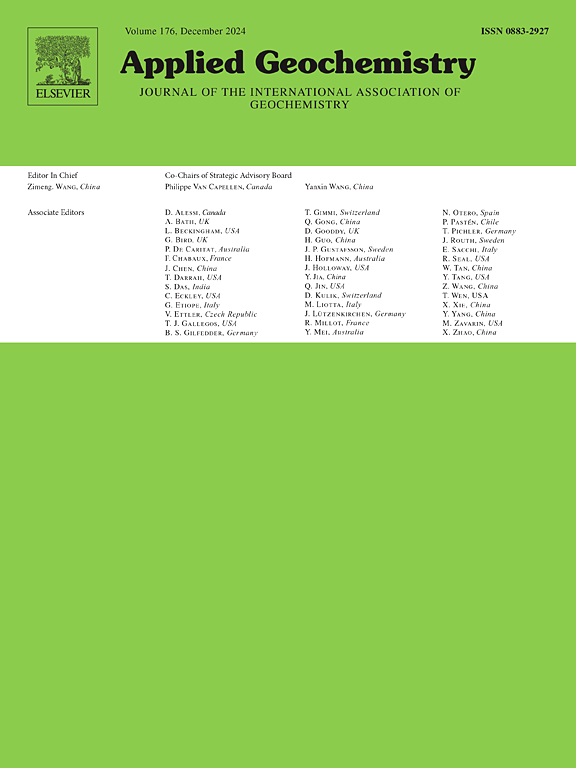The geochemical composition of Wellington soils and other New Zealand urban soils under different land-use
IF 3.4
3区 地球科学
Q1 GEOCHEMISTRY & GEOPHYSICS
引用次数: 0
Abstract
A recent soil geochemical baseline survey of the Wellington urban area analysed samples collected at multiple depths across 151 sites from a mixture of residential, commercial, industrial, pasture, native forest and exotic forest land. The parent material of Wellington soils is mostly chemically invariant, requiring data outliers to be explained by environmental or anthropogenic factors. Notable concentrations above guidance level environmental standards were found in surface (0–2 cm) and shallow (2–20 cm) soils for As, Cd and Pb. The concentration of these heavy metal contaminants in Wellington soils are likely associated with human activities, as the highest concentrations correlate to more densely populated urban areas, particularly where older pre-1960s housing stock exists. This pattern of heavy metal enrichment in New Zealand urban soils relative to regional soils is also observed in comparative urban studies in Auckland and Dunedin cities. Wellington urban soils overall have lower concentrations of Cd and higher concentrations of As, Pb, and Zn compared to Auckland and/or Dunedin. In contrast, Auckland and Dunedin urban soils have a broader enrichment in some heavy metals (including Cr, Cu, and Ni) directly associated with a strong geogenic influence from underlying volcanic geological sources, while Wellington urban soils are influenced by monolithic greywacke. This study also showed that the carbon content of soils in these three centres increases by up to 66 % with increasing latitude due to better C preservation in cooler southern climates. Moreover, urban soils are found to have lower C contents than native, pasture and exotic soils due to more rapid soil turnover rates which leads to increased microbial activity, although this is also dependant on plant type, with C4 grasses commonly found in the warmer and drier climates of Auckland being more recalcitrant in soil than C3 plants. Geochemical studies from across New Zealand show that both urbanisation and underlying geology exert a strong influence on elemental soil concentrations, with the highest heavy metal values commonly associated with cities with the longest history of European settlement. Climate and land use type are also key drivers for elemental retention in shallow soils.

不同土地利用方式下惠灵顿土壤及新西兰其他城市土壤的地球化学组成
最近对惠灵顿市区进行的土壤地球化学基线调查分析了在151个地点的多个深度收集的样本,这些地点包括住宅、商业、工业、牧场、原生森林和外来林地。惠灵顿土壤的母质主要是化学不变的,需要用环境或人为因素来解释数据异常值。在表层(0 ~ 2 cm)和浅层(2 ~ 20 cm)土壤中,砷、镉和铅的浓度明显高于指导水平环境标准。这些重金属污染物在惠灵顿土壤中的浓度可能与人类活动有关,因为最高浓度与人口更密集的城市地区有关,特别是在20世纪60年代以前的旧住房存量存在的地方。在奥克兰和达尼丁城市的比较城市研究中也观察到新西兰城市土壤中重金属富集相对于区域土壤的这种模式。与奥克兰和/或达尼丁相比,惠灵顿城市土壤总体上镉浓度较低,砷、铅和锌浓度较高。相比之下,奥克兰和达尼丁的城市土壤中某些重金属(包括Cr、Cu和Ni)的富集程度更广,这与下垫火山地质源的强烈地质影响直接相关,而惠灵顿的城市土壤则受到单片灰岩的影响。该研究还表明,这三个中心的土壤碳含量随着纬度的增加而增加了66%,这是由于南方气候较冷,碳保存得更好。此外,由于土壤周转率更快,导致微生物活性增加,城市土壤的碳含量低于原生、牧场和外来土壤,尽管这也取决于植物类型,但在奥克兰温暖和干燥的气候中常见的C4草比C3植物在土壤中更顽固。来自新西兰各地的地球化学研究表明,城市化和潜在的地质条件都对土壤元素浓度产生了强烈的影响,重金属值最高的城市通常与欧洲殖民历史最长的城市有关。气候和土地利用类型也是浅层土壤元素保持的关键驱动因素。
本文章由计算机程序翻译,如有差异,请以英文原文为准。
求助全文
约1分钟内获得全文
求助全文
来源期刊

Applied Geochemistry
地学-地球化学与地球物理
CiteScore
6.10
自引率
8.80%
发文量
272
审稿时长
65 days
期刊介绍:
Applied Geochemistry is an international journal devoted to publication of original research papers, rapid research communications and selected review papers in geochemistry and urban geochemistry which have some practical application to an aspect of human endeavour, such as the preservation of the environment, health, waste disposal and the search for resources. Papers on applications of inorganic, organic and isotope geochemistry and geochemical processes are therefore welcome provided they meet the main criterion. Spatial and temporal monitoring case studies are only of interest to our international readership if they present new ideas of broad application.
Topics covered include: (1) Environmental geochemistry (including natural and anthropogenic aspects, and protection and remediation strategies); (2) Hydrogeochemistry (surface and groundwater); (3) Medical (urban) geochemistry; (4) The search for energy resources (in particular unconventional oil and gas or emerging metal resources); (5) Energy exploitation (in particular geothermal energy and CCS); (6) Upgrading of energy and mineral resources where there is a direct geochemical application; and (7) Waste disposal, including nuclear waste disposal.
 求助内容:
求助内容: 应助结果提醒方式:
应助结果提醒方式:


